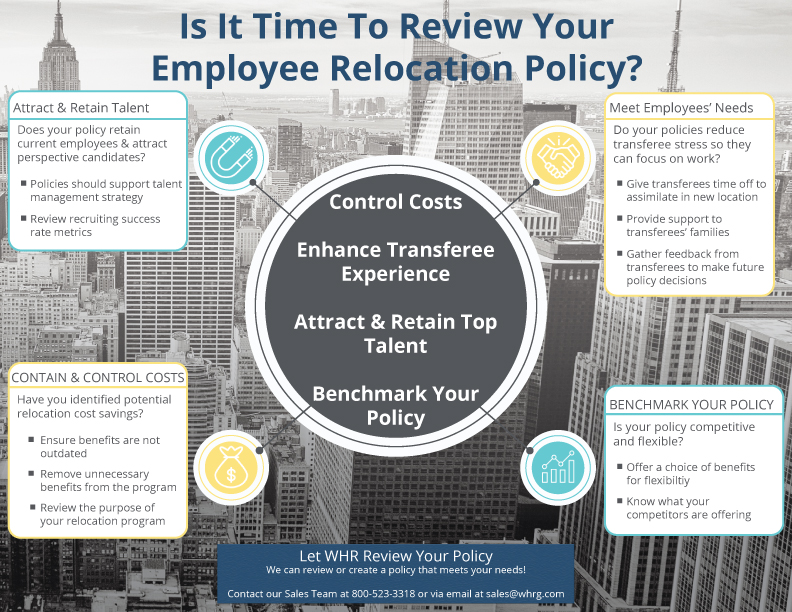COVID-19以降、リモートで働く従業員を含め、企業が遭遇した多くの変化を考えると、今すぐ自社の従業員移転ポリシーを見直す理由はないと思うかもしれない。しかし、そうではない。多くの企業が、必要な役割を果たすために従業員を転勤させています。今すぐポリシーを見直し、必要な調整を行うことで、次のような分野で組織を助けることができます:
- ビジネスコストのコントロール
- 従業員のニーズを満たすために
- 優秀な人材の確保と定着
- ベンチマーキング競合他社に対する自社のポリシー
以下の例は、WHRグローバルがクライアントのために実施したポリシーの見直しによるものです。これらの例は、リロケーション・ポリシーを定期的に見直すことがいかに重要であるかを示しています。
A.ビジネスコストをコントロールし、不要な福利厚生の支払いをやめる。
転勤者と組織のニーズの両方に適切な金額を配分していることを確認してください。また、不必要な手当や時代遅れの手当を支払っていないことも重要です。
- 例1
ある会社では、転勤者全員に転勤一時金として5千-1万ドルを支給し、余分な経費を補助していた。また、5,000~10,000ドルの一時金に加え、6週間の給与に相当する一時金を役員に支給していました。エグゼクティブの中には高給取りもいるため、この手当はエグゼクティブ一人当たり5万ドルにもなることもありました。検討の結果、私たちはその役員に対するこの慣習を減らすよう会社に提案しました。その結果、同社は数十万ドルを節約することができました。 - 例2
ある顧客は、従業員が物価の高い地域に転勤する場合、生活費の差額を支払っていた。彼らはこれを3-4年間支給し、さらに多額の一時金も支給していた。私たちは、最低5%の生活費基準額を設定することを勧め、わずかでも生活費の高い地域への転勤者に生活費を支払わないようにした。そのクライアントは数百万ドルを節約した。 - 例3
別のクライアントは、転勤を希望する現従業員に昇進以外のボーナスを支給していた。このボーナスは従業員の給与の5%に相当する。このような慣行は一般的ではないため、私たちはこのボーナスをリロケーション・ポリシーから除外するよう提案した。 - 例4
ある顧客がローン組成手数料を支払っていた。この手数料を請求しない金融業者もあるが、顧客が支払うことが分かっていれば、いずれにせよ手数料を請求する。このことに気づいた顧客は、必要なとき以外は手数料を支払わないようにした。
B.従業員のニーズに応える
リロケーション・ポリシーは、転勤者のニーズを満たすことが重要です。これにより、転勤者のストレスを軽減し、従業員が新天地での仕事に集中できるようになります。赴任者に新天地で適応するための休暇を与えること、赴任者の家族をサポートすること、赴任後のフィードバックを収集して今後の方針を決定することなどは、すべて赴任者のニーズに対応するのに役立ちます。
- 例1
あるクライアントは、海外転勤の際に一時金を支給していた。赴任後のアンケートから、赴任者が自分で国際家財便(HHG)を手配し、一時金全額を使わず、少しでも節約しようとしていることがわかった。また、従業員にそのような選択肢を与えることは、従業員にさらなるストレスを与え、移転プロセスを長引かせていることも、調査のフィードバックからわかりました。基本的に、転勤者はすべてを自分でこなし、小銭を稼ごうとしていたのだ。クライアントはすべての主要な給付を検討し、一時金は機能しないと判断した。一時金からコア・フレックス給付へとシフトした。つまり、HHG船積み、仕向け地サービス・プロバイダー、仮住まいをカバーするが、従業員の裁量で使用できる一時金を転勤者に支給したのである。これにより、転勤者のストレスが軽減されただけでなく、事業コストの抑制にもつながった。
- 例2
あるクライアントは、ヨーロッパ域内の転勤の配偶者/パートナーや家族にデスティネーション・サービスを提供していなかった。例えば、転勤者やその家族がロシアから英国に転勤する場合、転勤先でのサービスは必要ないと考えていたのである。赴任後の調査フィードバックを通じて、配偶者/パートナーがキャリア支援、語学研修、子供の学校探しの支援を必要としていることが判明した。従業員には新しい土地に馴染むためのオフィスワーカーがいたが、転勤者のパートナーは新しい言語に苦労し、食料品店などの生活必需品を探すのにさえ苦労していた。転勤者だけでなく、家族全体のニーズを把握することは、引っ越しと同化を成功させるために極めて重要である。
C.人材の確保と維持、競合他社に対する自社ポリシーのベンチマーク
転勤対策は、すでに貴社の総合的な報酬と人材管理戦略の一部になっていることを期待します。適切な方針は、御社が現在の従業員を維持し、将来性のある候補者を惹きつけるのに役立ちます。脆弱な転勤対策は、採用の成功率にマイナスの影響を与える可能性があります。
他社と比較することで、人材争奪戦における競争力を維持することができます。リロケーション・ポリシーは求人に含まれているため、貴社のポリシーが選択肢を提供するものであることを確認してください。競合他社をベンチマークしなければ、自社のサービスが優れているかどうかはわかりません。他の企業が提供しているものと比べて劣っていませんか?例えば、ハイレベルのエグゼクティブを採用する場合、その人材が非常に特殊で、簡単には手に入らないものであれば、給与、福利厚生、転勤規定で競争力があることを確認したいと思うでしょう。
同時に、ベンチマークを行うことで、競合他社が誰も行っていないような過剰なサービスを提供していないことを確認することができます。自社の方針を他と比較することで、業界と一致していることがわかります。また、自分の業界だけでなく、人材を獲得するために競合する他の業界にも目を向けることも重要です。
- 例1
競合他社がリロケーション・ポリシーに盛り込んでいる特典がないために、候補者を失うことを想像してみてください。例えば、候補者が完全なバイアウトを期待しているエグゼクティブであるにもかかわらず、貴社のポリシーにはHHGの移動と一時金しか含まれていない場合、上司と候補者と何度も交渉しなければなりません。これは多くの時間を浪費することになる。その間に、候補者は、より多くの転居手当を含む、より良い仕事のオファーを受けるかもしれません。リロケーション・ポリシーは、候補者にとって、ある仕事を他の仕事と比較する際の判断材料となり得ます。競合他社と自社の方針を比較したことがあれば、競合他社の方針がどのようなものであるかは既にご存知でしょう。
- Example #2
あるクライアントが、人材獲得チームから、特定のポジションを充足するのが難しいというフィードバックを受けていました。自社の方針を見直し、競合他社とベンチマークした結果、競合他社がはるかに豊富な赴任手当を提供していることがわかりました。その結果、その企業は、全額赴任手当の対象となる職種の範囲を拡大することにしました。
D.ポリシーはどのくらいの頻度で見直すべきですか?
WHRでは、従業員移転方針を毎年、あるいは長くても2、3年ごとに見直すことを推奨しています。大々的に見直す必要はありませんが、一旦立ち止まって従業員からのフィードバックに目を向けるチャンスです。さらに、企業文化、経営理念、基本的価値観、人材戦略、業界、競合の変化を確認する必要があります。見直しは、あなたの方針がこれらすべての要素や主要な利害関係者(人材獲得チーム、採用チーム、人事ビジネスパートナー)と一致していることを確認するための時間です。


